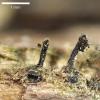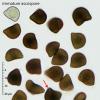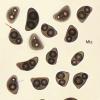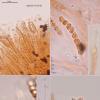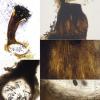
04-11-2025 12:43
 Edvin Johannesen
Edvin Johannesen
Hi! One more found on old Populus tremula log in O

04-11-2025 09:07
Hello.A suspected Hymenoscyphus sprouting on a thi

03-11-2025 21:34
 Edvin Johannesen
Edvin Johannesen
These tiny (0.4-0.5 mm diam.), whitish, short-stip

28-10-2025 15:37
Carl FarmerI'd be grateful for any suggestions for this strik

03-11-2025 16:30
 Hans-Otto Baral
Hans-Otto Baral
Hello I want to ask you if you have found this ye

28-10-2025 19:33
 Nicolas Suberbielle
Nicolas Suberbielle
Bonjour à tous,Je voudrais votre avis sur cette r

31-10-2025 09:19
 Lothar Krieglsteiner
Lothar Krieglsteiner
Can somebody provide me with a file of:Rogerson CT
Enigmatic pyrenomycete
Enrique Rubio,
01-01-2025 13:45
THE ASCI ARE CYLINDRICAL, WITH A DOUBTFUL OR INCONSPICUOUS APICAL APPARATUS MLZ. NEGATIVE AND THEY HAVE EIGHT OBLIQUELY UNISERIATE ASCOSPORES. THE PARAPHYSES ARE ABUNDANT, IN SOME CASES WITH MONILIFORM SEGMENTS AND THEY EXCEED THE LEVEL OF THE ASCI.
THE MATURE ASCOSPORES ARE BLACISH BROWN, THEY HAVE AT LEAST ONE GERM PORE (RED ARROW), SOMETIMES TRANSVERSE SEPTA, A COMPLEX SYMMETRIY AND PERHAPS A SHORT GERM-SLIT ONLY WELL VISIBLE IN MELZER'S REAGENT (BLUE ARROW).
I CANNOT FIND AN APPROPRIATE GENUS FOR THIS FUNGUS, NOT EVEN WITHIN THE MELANOSPORALES, SO I AM ASKING FOR SOME CLUE TO SOLVE THIS ENIGMA.
I WOULD LIKE TO TAKE THIS OPPORTUNITY TO WISH YOU A HAPPY NEW YEAR.
Alain GARDIENNET,
03-01-2025 08:17
Re : Enigmatic pyrenomycete
Hi Enrique,
Your fungus should not be too far from Bellojisia rhynchostoma.
Happy new year for you, and forum !
Alain
Your fungus should not be too far from Bellojisia rhynchostoma.
Happy new year for you, and forum !
Alain
Thorben Hülsewig,
03-01-2025 10:48
Re : Enigmatic pyrenomycete
Hi Enrique,
Perhaps you have found Corylomyces selenospora.
best regards,
Thorben
Perhaps you have found Corylomyces selenospora.
best regards,
Thorben
Enrique Rubio,
03-01-2025 12:45
Re : Enigmatic pyrenomycete
Some colleagues had initially pointed me towards Corylomyces and later towards Bellojisia. I think this fungus could belong to the latter genus, because by the morphology of the ascomata, the asci with an inconspicuous apical apparatus and the presence of abundant paraphyses. But the spores are quite different from those of J. rynchospora. Unfortunately there is too little material to attempt a culture and sequencing, but I am very grateful for your help.

